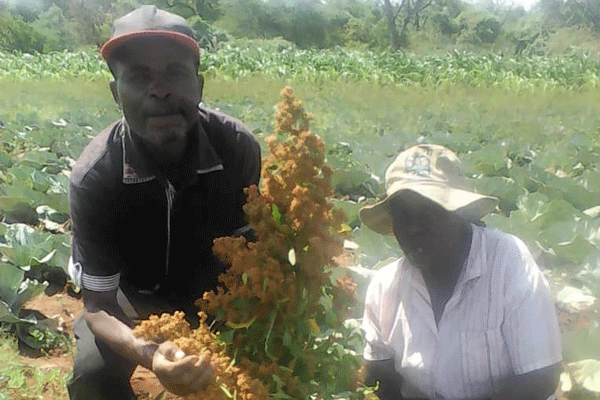
For Zimbabwe’s dry regions struggling to ensure household food security in the face of climate change-induced droughts, the quinoa crop offers an opportunity to escape the vicious cycle.
BY MTHANDAZO NYONI
Originally from the Andean region of South America, the quinoa crop is a flowering plant offering prospects for diversifying agricultural production and improving household food and nutrition security.
The plant has edible brown or white seeds, but it is not a true cereal.
Research shows that its young leaves can be eaten as a vegetable, similar to spinach, and its seeds have higher energy content than barley, oats, rice, maize and wheat as well as higher levels of calcium, phosphorus, iron, fibre, and Vitamin B.
As Zimbabwe is currently severely affected by climate change, with drought impacts leading to serious water shortages, declining maize yield, and periods of food insecurity, quinoa production is considered as a panacea alongside other small grains.
Last year, Sizimele Consortium in conjunction with the Organisation of Rural Associations for Progress (Orap) piloted production of the quinoa crop in Matabeleland region after it was successfully tested at Midlands State University (MSU).
Sizimele programmes manager Diego Matsvange told The Standard that the pilot project was successful, and they were looking forward to increasing production this season.
- Chamisa under fire over US$120K donation
- Mavhunga puts DeMbare into Chibuku quarterfinals
- Pension funds bet on Cabora Bassa oilfields
- Councils defy govt fire tender directive
Keep Reading
“Now we are in the process of rolling it out to other districts such as Matobo, Lupane and Insiza with a view of scaling up production.
“We are targeting 3 000 farmers, with each farmer expected to plant at least 0,5 hectares of quinoa, translating to 1 500 hectares in total,” Matsvange said. “It’s a crop that has got a lot of advantages and is good in terms of drought tolerance.
“It has worked perfectly well in countries such as Ethiopia and it compares well with our sorghum, rapoko and millet.
“But it can yield much more than sorghum under similar climatic conditions,” he said, adding the crop can be grown twice a year.
Matsvange said quinoa is quite adaptable to the current climatic conditions, especially in the Matabeleland region.
“It can be processed into soap, maputi (popcorn), biscuits and flour. The challenge now is low production,” he said. “Demand is huge and we are failing to satisfy it.
“The market is readily available, especially outside the country,” he said.
“We would like to encourage farmers to take up quinoa production, but we are not saying they should stop producing other crops such as millet, sorghum and maize.
“They must weigh the options.”
The project, funded by the Zimbabwe Resilience Building Fund (ZRBF), is set to be rolled out in the country in the next two years.
Abel Moyo from Silalatshani in Filabusi, who is one of the crop pioneers in the country, said quinoa is a “wonder crop”.
“I started growing this crop last year and managed to harvest about seven buckets (140kg) of it.
“This year I am planning to increase production and plant about 0,5 hectares.
“The crop is very useful in terms of nutritional value, food security and offers some financial rewards.
“The crop only takes three months to mature. So it can be grown four times a year,” Moyo said.
Moyo, however, said the biggest challenge they were facing as farmers was poor markets.
“We have a challenge of buyers, who are currently very few in the country and because of that, middlemen come and rob us,” he said.
“So we need reputable buyers,” he emphasised, adding more villagers had expressed interest in growing quinoa this season.
Another communal farmer also from Silalatshani, Sipho Kamanga, said: “Last year I harvested three buckets (60kg) of quinoa and I am looking forward to growing it going forward.
“Compared to maize, I think quinoa can give you better rewards, provided the issue of the market is addressed.”
Zibusiso Sibanda, a farmer from Gwatemba in Filabusi, said he was expecting to plant the crop again this season.
Agritex officer for Silalatshani Noel Shava encouraged communal farmers in drought-prone areas to try quinoa.
“It is a new crop and in Silalatshani it was first piloted by two people and it did well,” Shava said.
“For this season, we are expecting to increase production. Now, we are still registering farmers,” he said.
On the issue of markets, Shava said: “Sizimele Consortium has promised to assist in that regard.” He said the crop can be planted throughout the season and is not labour-intensive.
Currently, quinoa cultivation occurs in more than 70 countries, including Kenya, Ethiopia, India, United States, France, England, Sweden, Denmark, Holland and Italy. Due to its adaptability to different environments as well as its dietary benefits, it has the potential to lessen dependence on staples such as maize, wheat and rice, says the Agriculture Marketing Resource Centre (AMRC) of the United States.
The AMRC says the crop can potentially uplift places that suffer from food insecurity.
If grown at a larger scale, local farmers can also export the crop to countries such as the US and Europe.
The price of quinoa has also increased dramatically, nearly tripling between 2006 and 2013 due to high demand in the United States and Europe, according to the AMRC.
Compared to maize, quinoa prices are better. For instance, a kilogramme of quinoa costs around US$5 on average worldwide while for maize it is around US$0,30c. Grain quinoa, research says, can be used as side dishes similar to rice, flaked as a breakfast cereal, added to snack foods and pasta, in multi-grain infant cereals and in ground flour.
Because quinoa is gluten-free, it reduces bread volume by more than 10% when baked.
The thinning from quinoa production can be incorporated into salads while its leaves can also be used for livestock feed.
The Food and Agriculture Organisation says quinoa is recognised not only for its nutritional and dietary properties, but also for its genetic diversity, adaptability to different agro-environmental conditions as well as the cultural and socio-economic benefits it has on the local environment.
The promotion of quinoa is part of a broader FAO strategy to encourage the cultivation of traditional or forgotten crops as a means of contributing to food security.
The United Nations General Assembly declared 2013 as the “International Year of Quinoa” in recognition of ancestral practices of the Andean people, who have managed to preserve quinoa in its natural state as food for both present and future generations.
Matabeleland South, Matabeleland North, Midlands and Masvingo are some of the provinces in Zimbabwe that have successively suffered the effects of drought, which has been blamed on climate change.
Addressing journalists at a workshop on environment and climate change reporting organised by the Cultural Information Trust in Dete recently, climate change expert Raymond Mugandani said climate change severity, intensity and impact continued to soar in Zimbabwe.
As such, there is a need for people to diversify their crops to combat it, he said.
“People should cultivate crops that tolerate high levels of stress like quinoa, a new crop set to be introduced in Zimbabwe,” Mugandani said.
“Climate change is worse than Covid-19 and for the country to achieve sustainable development goals (SDGs), there is need to combat climate change.”
Small grains, which include sorghum, pearl and finger millet, are also seen as the answer to food security in the country, especially at a time climate change threats on agriculture continue.
But the challenge is on the availability of seed.
“In the 2019/2020 season, 60% of the farmers in the province adopted traditional grains cropping, especially in smallholder set-ups,” Midlands provincial crops and livestock officer Medlinah Magwenzi said.
“We could have gotten 90%, but seed availability was limited, hence only those that got it from the presidential inputs scheme planted.
“I am hopeful that if adequate seed is available almost all farmers would (be interested) because they have seen the benefits of drought tolerance, nutritional cereals that are easy to grow.”
Small grains are ranked as Zimbabwe’s second staple crop after maize.
By threatening agricultural livelihoods, droughts are also hampering the achievement of the SDGs in Zimbabwe, notably SDG1 aimed at eliminating poverty, SDG2 (zero hunger), and SDG3 (good health and well-being).










